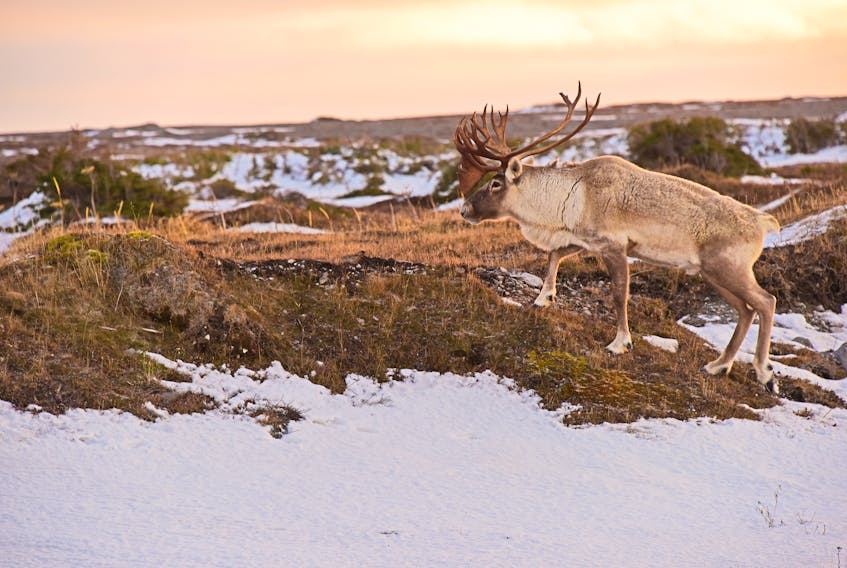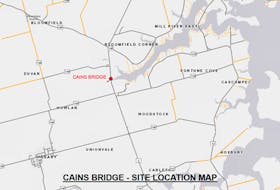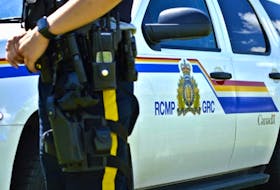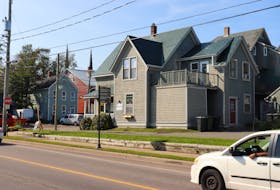Newfoundland’s caribou population is only a third of what it used to be, but it’s not something that should be sounding alarm bells, says Wayne Barney, senior biologist with the Department of Natural Resources wildlife division.
The population peaked in the mid-'90s at approximately 95,000, and current estimates set it at just under 30,000 animals.
“The cycle for caribou is quite long and it generally doesn’t show signs of recovery in an annual perspective that we see from year-to-year,” Barney said, noting it took decades for the herd to reach its peak.
But the population is still lower than it used to be and calf recruitment is playing the biggest factor in the overall picture.
Barney said calves aren’t meeting the 15 per cent survival rate required to sustain the population.
Predation appears to be the key contributor. This would be coyotes, bears, lynx and eagles.
“The human impact is certainly harder to tease out from a calf survival perspective as a direct influence,” he said. “Hunting wouldn’t be of a significant concern for us, because there would be a very low selection on calves.”
However, a new concern has reared its head.
“It doesn’t mean that alarm bells should go off, it’s just that we don’t want hunting to further contribute to a population decline." — Wayne Barney, senior biologist with the Department of Natural Resources wildlife division
While wolves were extirpated in the 1930s, a resurgence appears to be happening.
Coyote and wolf hybrids are being discovered, with the first confirmed report in 2008 and the most recent in 2016, according to Barney.
“These hybrids are a product of a wolf population that has encroached upon an established coyote population,” he said. “Most of the research we have done is kind of leaning towards that Labrador wolves that got to the island.”
If the species can establish itself in Newfoundland, Barney said, it could have a significant ecological impact, and the influence of wolves on caribou populations is currently being studied.
To help mitigate predation factors, the province executes two licensed bear hunts per year and a coyote season is in place from September to mid-July.
The department will be conducting its annual survey later this month to look at all caribou herds from the west coast to the Bay d’Espoir highway, and along the south coast.
If there’s any concern about a population’s status, the annual harvest will be adjusted accordingly.
The department issues fewer licenses than the population might support, just to be safe.
“It doesn’t mean that alarm bells should go off, it’s just that we don’t want hunting to further contribute to a population decline,” Barney said.
|
Region |
Herd |
Population Estimate |
|||
|
Previous |
Current |
||||
|
Survey Year |
Estimate |
Survey Year |
Estimate |
||
|
South Coast |
Buchans |
2007 |
4,474 |
2016 |
4,023 |
|
Gaff Topsail |
2,182 |
1,637 |
|||
|
Grey River |
1,222 |
1,867 |
|||
|
LaPoile |
5,610 |
3,418 |
|||
|
Pot Hill |
3,066 |
1,475 |
|||
|
Mount Peyton |
674 |
561 |
|||
|
Northern Peninsula |
Gros Morne |
2008 |
837 |
2017 |
360 |
|
Hampden Downs |
413 |
334 |
|||
|
Hodges Hill |
436 |
259 |
|||
|
Northern Pen. |
5,811 |
1,315 |
|||
|
Adies Lake |
608 |
201 |
|||
|
Gregory Plateau |
206 |
282 |
|||
|
St. Anthony |
2,162 |
1,999 |
|||
|
Middle Ridge |
Middle Ridge |
2010 |
8,814 |
2018 |
11,547 |
|
Island of Newfoundland |
Total Estimate |
2008 |
38,241 |
2018 |
29,411 |
* Island of N.L. totals does not match the total of all herd estimates contained above, as other herds contribute to the total number.
— SOURCE: DEPARTMENT OF FISHERIES AND LAND RESOURCES
The state in central
Breaking down herd populations in central Newfoundland can be a bit misleading, according to Barney, who defined a caribou herd as where females collectively go to calf. Caribou are migratory animals and calving grounds can fall outside of central Newfoundland.
But there are monitored populations within the central region, such as the Hodge’s Hill group, north of Grand Falls-Windsor, and the Mount Peyton group which can be spread throughout central and as far east as Clarenville.
Mount Peyton, as of its last survey, has 561 animals and Hodge’s Hill’s 259 animals. Both have shown some decline. It’s not something Barney is overly concerned about, as it’s reflective of the provincial decline as a whole.
Isolated growth
After a couple of concerning years, Fogo Island, with 317 caribou in 2018, has shown signs of improvement.
A 2017 study indicated the population declined from 353 animals to 215 in just two years. This resulted in a reduction of annual harvest licenses from 50 to 25.
Memorial University professor Eric Vander Wall has been heading up the Fogo Island Ecology Project since 2014. The group carries out behavioral studies for a small population of the herd.
Vandar Wall said there was a bit of a scare when the survey numbers were released, but he feels the herd is doing well.
“I think we are in a stage where the population has been in five-six years, that it doesn’t want to outgrow the resources,” he said.
Reducing hunting activity, he said, was the right decision.
“The animals taken in a hunt aren’t necessarily the ones that would die during a bad winter or through age,” Vandar Wall said.
“We have to be careful when we are expecting populations to start a natural decline and do whatever we can not to exasperate that decline.”
Signs of change
Greg Jeddore, forestry manager for Natural Resources with the Miawpukek Mi'kamawey Mawi'omi in Conne River, said the First Nations group has been monitoring caribou populations for years.
Caribou for the Miawpukek community have been part of a way of life, since becoming a permanent settlement in 1822, and, prior to, as one of the many semi-permanent camping sites used by its people.
“We use caribou for food, tools and medicine,” said Jeddore. “They play a major role in our history and our culture.”
Jeddore said while the population is down compared to historic highs, there appears to be some signs of recovery.
The Middle Ridge population, for example, has increased from 8,814, in 2010, to 11,547 in 2018.
He feels this sign of recovery is the result of caribou having readjusted to their habitat, as climate change is producing longer, hotter summers. Industry, such as timber harvesting, having encroached on feeding grounds, and an increased predation presence through coyotes have also played their parts.
“It changes the migration pattern and finding new ways to survive,” he said. “Now we are noticing they are slowly coming back. They are adjusting to changes on the landscape and coyotes.”
Jeddore says the band does what it can to assist with recovery as well.
Along with local trappers helping keep coyote populations in check, the band has fishery and river guardians in place monitoring the area, to make sure caribou populations aren’t being disturbed.
It is also carrying out the replanting of caribou friendly trees to help with habitat loss.
“If you’re going to have a healthy heard, you need a healthy environment for them as well.”
Related stories:
Nunatsiavut calling for all harvesting of George River caribou to cease









